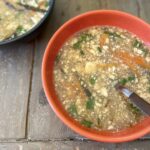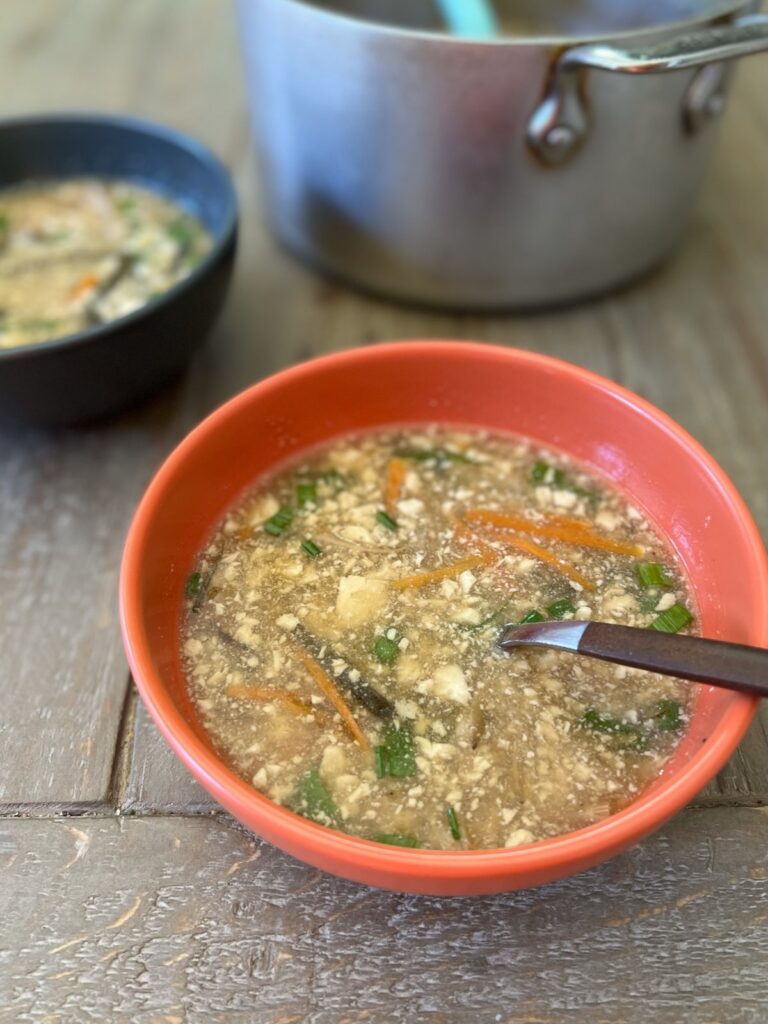
When the temps drop and fall begins to settle in, I think of warming bowls of spicy, tangy, slightly rich soup. Those words describe many Asian soups, including those from Southeast Asia. My ideal are soups that taste luxe and rich but don’t weigh you down. Hot-and-sour soup, a Sichuan icon, is one of them. It’s a standard at Chinese restaurants that’s totally doable at home. I’ve made suan la tang (hot-and-sour soup in Mandarin) for decades but never a vegan version.
There’s plenty of savory depth and different kinds of vegetables to lend texture and excitement – which I like in a nice bowl of hot-and-sour soup. Bits of shredded meat and batons of tofu often serve as the protein elements in conventional hot-and-sour soup (here's my recipe), but in this vegan take, it’s all tofu. Flavor-wise, soy sauce, Shaoxing rice wine, and salt lend depth while white pepper and vinegar drive the hot-and-sour signature flavor. Kombu and dried shiitake mushroom contribute their umami goodness. This vegan hot-and-sour soup satisfies as a small bowl to serve with other dishes. I’ve also served larger portions with bread (or corn quesadillas) on the side. It keeps well for days so you can dole it out for quick lunch. Here are my notes for you along the way!
Easy Fake Egg
Chinese hot-and-sour soup typically has egg stirred in the end for a gossamer finish. The soup becomes elegant with that egg addition. I pondered using fake egg, but at the grocery store, wondered if silken tofu would work. It did. I selected tender silken tofu that is molded into the tub, NOT sitting in a moat of water. (That kind of tofu is firmer.) The tender silken tofu got stirred up and once added to the pot, resembled eggy bits suspended throughout. It was fun to see the transformation and use tofu in this manner. The silken tofu enhanced the vegan hot-and-sour soup with its protein while mimicking egg to boot. Yay!
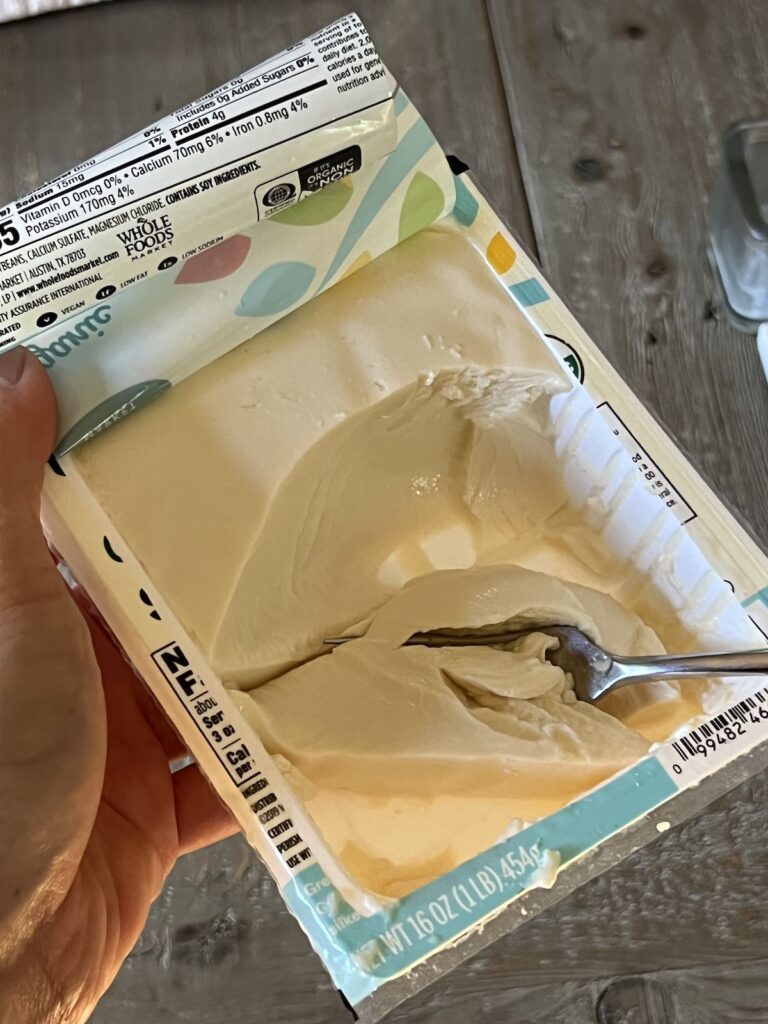
Dried Lily Bud Primer
You may already have all the ingredients for vegan hot-and-sour soup in your pantry, but perhaps not dried lily buds. A Chinese ingredient, the dried buds are simply the unopened buds of the day lily flower. They are tender-chewy, with a mild tangy, earthy flavor. Why use dried lily buds in hot-and-sour soup? The buds add intriguing flavor and textural notes to hot-and-sour soup.
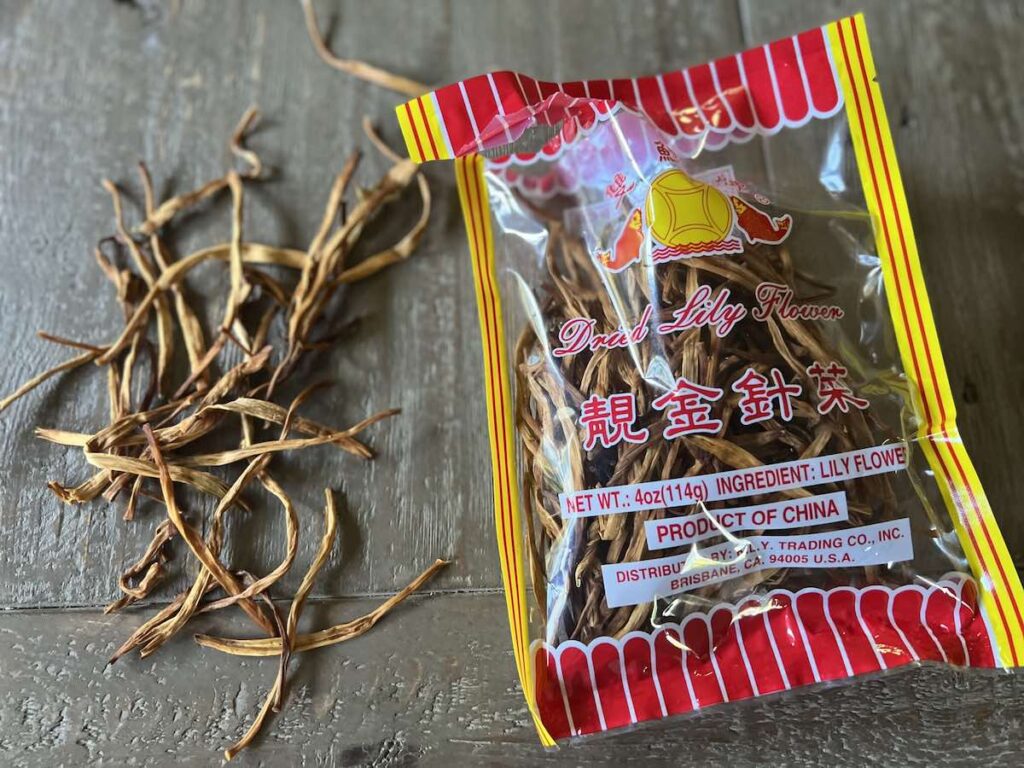
Dried lily buds may also be called golden needles. In Chinese, they are called huang hua (黄花), which means yellow flower. To prep dried lily bulbs, check each for a little tough nob at the end. If it’s there, snip or break it off first. Soak the buds in water until softened to use; dried lily buds will turn the water yellowish color.
Where to find dried lily buds? At a Chinese or Vietnamese market, check near the dried mushrooms and beans for dried lily buds. Like dried mushrooms, dried lily buds keep well for a very long time. While you’re at the Asian market shopping for the lily buds, pick up the kombu and shiitake for this soup. They are likely shelved nearby or in an adjacent aisle. Note that dried lily buds are different from dried lily bulbs, which are starchy in texture. You could substitute canned shredded bamboo shoots but the flavor would not be quite the same; you may get more of a musty earthiness.
Along with the seaweed (affordable dashi kombu works great), shiitake mushroom, and carrot, the dried lily buds inject interesting flavor, color and texture into this vegan hot-and-sour soup.
Vinegar Options
Chinkiang vinegar is often used to lend a tart edge to hot and sour soup. You can pick up a bottle at a Chinese market, as well as at well-stocked Southeast Asian grocers and pan-Asian grocers. Golden Plum is a reliable brand. The vinegar is fantastic with dumplings, especially xiao long bao soup dumplings. If you don't have it, use apple cider or combine apple cider with balsamic.
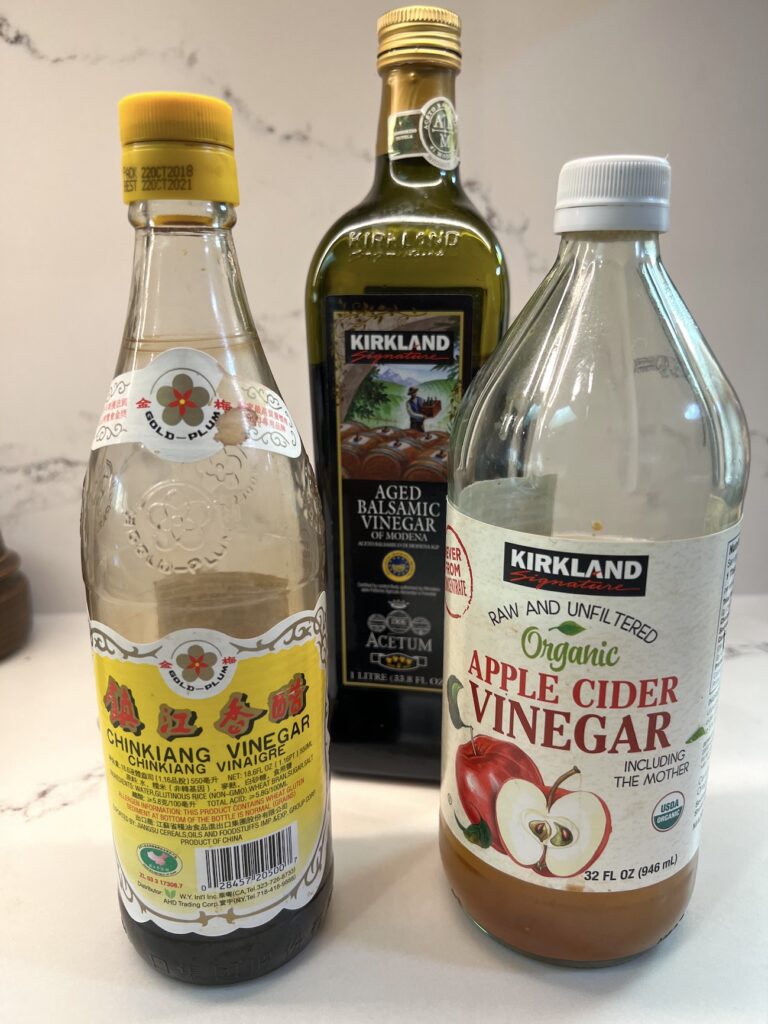
Why White Pepper?
Many people assume that the hot in hot-and-sour soup is chile but it's really white pepper. White pepper is ripe black peppercorns that have been soaked and stripped of their outer layer. Good white pepper has a distinctive pungent mustiness that goes super well with the other ingredients. Sometimes white pepper goes though a fermentation process that makes it a bit savory. Pre-ground white pepper is sold at many East and Southeast Asian markets, but you'll get the best flavor from grinding your own.
Vegan Hot-and-Sour Soup Video Recap
For a visual summary of how the soup comes together, here's what happened in my kitchen! I hope it's helpful, even though this is straightforward recipe.
If needed, de-activate any ad-blocker to see the video. And when the video prompts you to "Stay", select stay.
Vegan Hot-and-Sour Soup
Ingredients
- 6 ½ cups water, plus more as needed
- 3 by 4-inch piece kombu
- ½ ounce dried shiitake mushroom
- 36 dried lily bulbs, knobby ends trimmed
- 1 carrot, cut into matchsticks
- 2 tablespoons neutral oil, such as canola
- ½ medium yellow onion, thinly sliced
- 1 ½ teaspoons packed minced fresh ginger
- Fine sea salt
- 1 ½ tablespoons regular soy sauce
- 1 tablespoon Shaoxing rice wine or dry sherry
- MSG or Asian mushroom granules (optional)
- 16 ounces silken tofu
- About ¾ teaspoon white pepper
- ¼ cup cornstarch
- About 2 tablespoons Chinkiang or apple cider vinegar, or 1 ½ tablespoons balsamic plus ½ tablespoon apple cider vinegar
- 1 cup chopped green onions, green parts only
Instructions
- In a 3- or 4-quart pot, combine the water, kombu, shiitake mushroom, and lily buds. Set aside for at least 6 hours to fully rehydrate, or up to overnight. After the dry ingredients have sufficiently soaked, retrieve the solids. Thinly slice the kombu into 2 to 3-inch strips. Thinly slice the shiitake caps and any stems that are not too chewy. Set aside with the lily buds and carrot.
- Set the pot of broth over medium heat and bring to a boil.
- Meanwhile, heat the oil over medium heat. When barely rippling, add the onion and then cook, stirring for 3 to 4 minutes, until soft and sweetly fragrant. Add the kombu, mushroom, lily buds, carrot, and ginger. Season with ½ teaspoon salt, soy sauce, and rice wine. Stir, and cook for about 2 minutes to develop a bit of flavor and then scrape into the broth pot.
- Bring the soup to a boil, lower the heat to gently boil, and let cook for 3 to 5 minutes to meld and develop flavor. Add the white pepper. Taste and season with about ¼ teaspoon MSG, ½ teaspoon mushroom seasoning granules, or extra salt.
- Pour off any water from the tofu. Transfer to a bow (or keep in the tub) and use a fork to break it up into a curd-like texture resemble eggy bits (watch the video if you need an assist). Add to the soup. Bring to a gently boil.
- Meanwhile, combine the ¼ cup of cornstarch with ¼ cup water, stirring to dissolve. When the soup has bubbly action, gradually stir the cornstarch into the soup. You may not need the entire amount to create a silky, thick finish with the tofu suspended in the liquid.
- Turn off the heat and stir in the green onion and vinegar (see Note if serving over days). Retaste to check the savory, pungent heat in the soup, adding extra white pepper and, if needed, extra salt, MSG or mushroom granules. Ladle into a serving bowl or individual soup bowls and serve!













